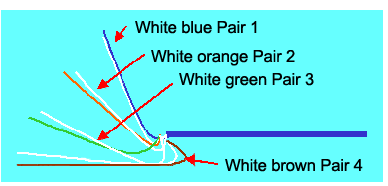What you need to know before you start
Use of this guide is at your own risk. Although the voltage on active telephone wiring is typically very small it can be hazardous to some individuals and materials. In addition, telephone wiring can conduct dangerous electrical shocks if it comes into contact with power wires, caution should be used when working near or around electrical wiring.
Bell Aliant and affiliates have no responsibility for any personal injury or property damage which may result from your installation or attempted installation of inside wiring as discussed in this guide. Bell Aliant and it affiliates specifically disclaim any liability for such injury or damage. By proceeding with this installation, you assume all risk of personal injury or property damage. If you have a single line residence or business telephone service, you are responsible for the installation and maintenance of telephone wiring inside your residence or business.
If you have a party line or your service terminates on a hardwired set, these changes do not apply to you and Bell Aliant will continue to repair inside wiring as part of your basic service.
Wiring for High Speed Services
To ensure your home is ready to accept the new multi media services available in the future, your home's inside wiring is of utmost importance. To carry services like Digital TV, High Speed Internet, and Home networking without limitations your inside wiring must be up to standard. The components of a structured wiring system differ greatly from plain old telephone service (POTS) when it comes to moving data and other communications signals.
Category 5e Twisted Pair Wire (for Voice and Data). This replaces Category 1 wiring designed primarily for voice communications, not high speed data transfer (which it slows to about 4 megabytes per second). Category 5e, by contrast, moves voice and data at a minimum of 100 megabytes per second and supports local area networks (LANs), providing the ability to use a home printer from the kitchen laptop, for instance. Cat 5e, which costs about 40 per cent more than Cat 1, also serves as the data line for Digital TV. See Figure 2.
RG 6 Dual Coaxial Cable (for Video). This replaces RG 59, a 20 gauge conventional cable that comes to the box and into the house at one location only. With dual RG 6 cables routed to selected ports throughout the house, each TV can receive its own signal or share it with other TV or computer monitors. It can also receive and send images from security cameras and the Web. The first cable sends the signal to an outlet, while the second cable distributes the signal with in the house. The 18 gauge cable also loses less of the signal (5.9 decibels vs. 7.1 decibels for RG 59). RG 6 costs twice as much as its obsolete predecessor, because you are installing twice as much cable; cost per foot is the same as RG 59.
Central Distribution Hub. Whether standard or optional, the hub enhances a structured wiring system, allowing LANs and dedicated signals for extra phone, fax, and data lines from a centralized location, and managing the myriad of signals and services coming from the curb. Costs vary and are usually included in a structured wiring package.
Figure 1

This type of wiring can be done by either a Bell Aliant technician or a qualified contractor. Call Bell Aliant at 611 for information on charges that apply.
Figure 2

CAT5 Wire contains 4 Wire Pairs:
- White and Blue for Voice
- White and Orange for Data
- White and Green for Data
- White and Brown for Data
Issues to consider when installing Cat 5e are: maximum bending radius, pulling tension, proximity to electrical sources, and circuits, method of attachment. This information is available from the CSA T525-94 Standard.
Additional Information
- Ensure that technicians are qualified. Bell Aliant technicians are trained and knowledgeable.
- Contact your city/town planning department to ensure any local codes are followed.
- Please call Bell Aliant at 611 if you require additional information on single line inside wire.
- If you require additional information on wiring standards, you can order the publication Residential Wiring for Telecommunications (T525-94) from the Canadian Standards Association or visit www.csa.ca.